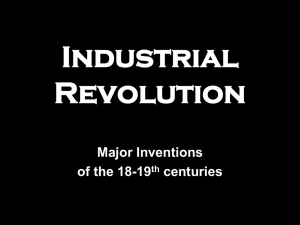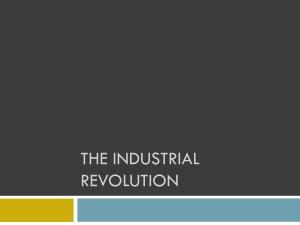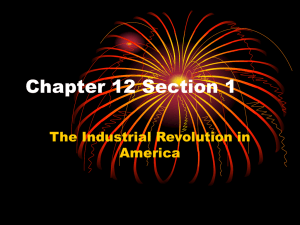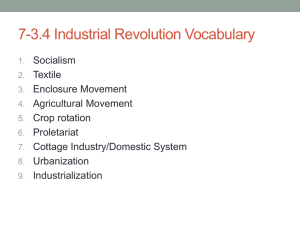Industrial_Revolution\Industrial_Revolution_F
advertisement
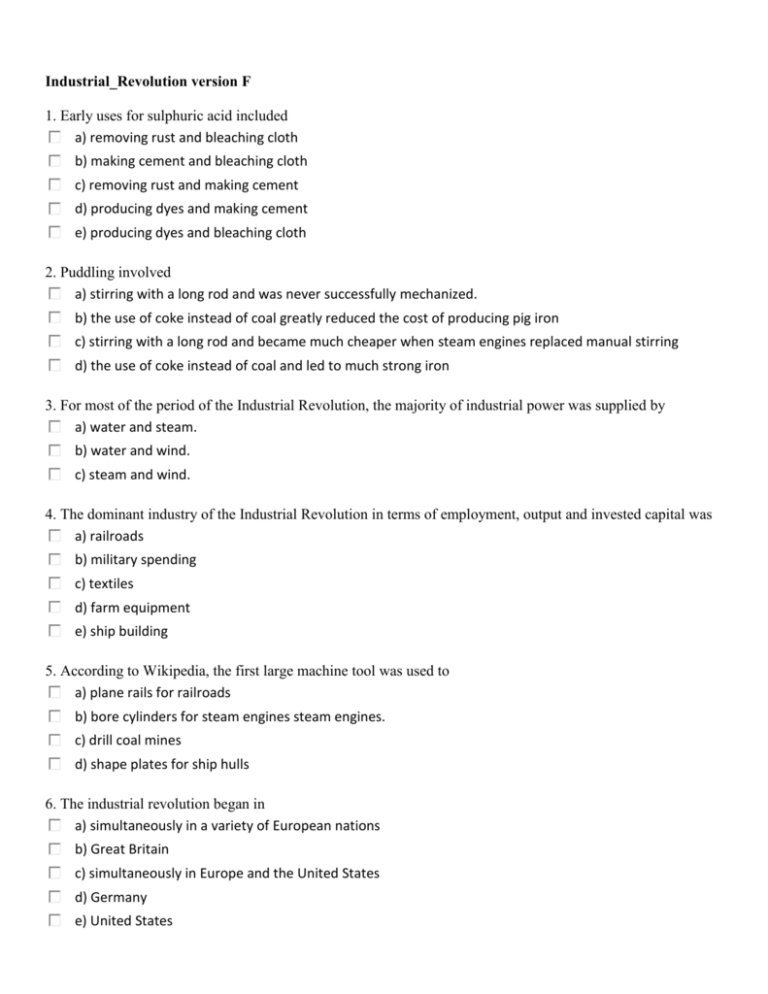
Industrial_Revolution version F 1. Early uses for sulphuric acid included a) removing rust and bleaching cloth b) making cement and bleaching cloth c) removing rust and making cement d) producing dyes and making cement e) producing dyes and bleaching cloth 2. Puddling involved a) stirring with a long rod and was never successfully mechanized. b) the use of coke instead of coal greatly reduced the cost of producing pig iron c) stirring with a long rod and became much cheaper when steam engines replaced manual stirring d) the use of coke instead of coal and led to much strong iron 3. For most of the period of the Industrial Revolution, the majority of industrial power was supplied by a) water and steam. b) water and wind. c) steam and wind. 4. The dominant industry of the Industrial Revolution in terms of employment, output and invested capital was a) railroads b) military spending c) textiles d) farm equipment e) ship building 5. According to Wikipedia, the first large machine tool was used to a) plane rails for railroads b) bore cylinders for steam engines steam engines. c) drill coal mines d) shape plates for ship hulls 6. The industrial revolution began in a) simultaneously in a variety of European nations b) Great Britain c) simultaneously in Europe and the United States d) Germany e) United States 7. On the eve of the Industrial Revolution, when the textile industry was largely a cottage industry, men did the ______ and women did the _______. If a loom was used, the work done by the men required ______ person hours. a) spinning, weaving, fewer b) weaving, spinning, fewer c) weaving, spinning, more d) spinning, weaving, more 8. On the eve of the Industrial Revolution, when the textile industry was largely a cottage industry, women did the ______ and men did the _______. If a loom was used, the work done by the women required ______ person hours. a) spinning, weaving, fewer b) weaving, spinning, more c) spinning, weaving, more d) weaving, spinning, fewer 9. What impact did the industrial revolution have on living standards of ordinary people, according to Wikipedia? a) little or no growth in the first half, but enormous growth in the second half of the industrial revolution. b) little or no growth until much later (19th and 20th centuries) c) the question is a subject of controversy d) sustained growth, for the first time in history 10. Manchester acquired the nickname __________ during the early 19th century owing to its sprawl of ______ a) Cottonopolis, textile factories b) Coalopolis, coal mines c) Cokopolis, coke processing plants d) Weavopolis, Weaving factories 11. During the Industrial Revolution, the best Chemists were trained in a) Germany b) Great Britain c) Italy d) United States e) Sweden 12. The Industrial Revolution began shortly before a) the American revolution (1776) b) World War I (1914) c) the American civil war (1861) 13. The Calico Acts were initially designed to protect a) domestic cotton production b) small manufacturers c) large manufacturers d) the woollen industry 14. Cartwright built two textile factories. One of them a) was sabotaged by workers b) was transported to Germany c) burned down d) is still in use today e) two of these are true 15. Which is NOT one of the three areas of development that helped initiate the industrial revolution? a) textiles b) iron making c) steam power d) assembly lines 16. The Miner's Friend a) pumped water b) was electrical lighting c) transported miners d) provided ventilation 17. A major change in the metal industries during the era of the Industrial Revolution was the replacement of wood and other bio-fuels with coal. Compared to wood, coal required a) less labour to mine, but was less abundant (until the Rineland coal fields were discovered). b) about the same labour to mine, but was more abundant than wood. c) less labour to mine and was also more abundant. 18. During the Industrial Revolution, the cost of producing sulfuric acid greatly improved by a) replacing glass containers with lead containers b) replacing iron containers with glass containers c) replacing glass containers with iron containers d) replacing lead containers with glass containers 19. The purpose of Eli Whitney's cotton gin was to a) spin cotton b) weave cotton c) clean cotton d) pick cotton e) remove seeds 20. Henry Cort developed rolling, which is 15 times _____ than ______ a) faster, hammering b) cheaper, hammering c) cheaper, puddling d) faster, puddling 21. The Industrial Revolution lasted just under _____ years a) 400 b) 600 c) 50 d) 1000 e) 200

